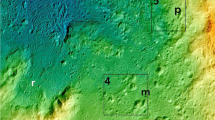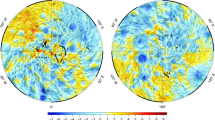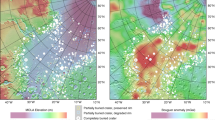Abstract
The intimate mixture of ice and silicate within the uppermost few kilometres of Ceres influences its geology and the evolution of its subsurface. Both ground ice and cryovolcanic processes have been hypothesized to form geologic terrains on Ceres, including within Occator crater, where they have been suggested to influence the post-impact surface evolution. Both types of processes involve the presence and expression of volatiles and brines, such that distinguishing between them could be difficult. Here, we use images and topography data from the NASA Dawn mission to investigate the morphology, age and distribution of mounds and hills within Occator crater, and infer their origin. The shapes and relative ages of many of these features suggest that they formed as impact-induced water-rich flows that covered the crater floor refroze in a manner similar to the formation of periglacial ice-cored mounds on Earth called pingos. We suggest that impacts on Ceres produced hydrologic conditions for surface changes in the absence of cryovolcanic processes. Our findings imply that cryo-hydrologic processes extend beyond Earth and Mars, and have been active on Ceres in the geologically recent past.
This is a preview of subscription content, access via your institution
Access options
Access Nature and 54 other Nature Portfolio journals
Get Nature+, our best-value online-access subscription
$29.99 / 30 days
cancel any time
Subscribe to this journal
Receive 12 print issues and online access
$259.00 per year
only $21.58 per issue
Buy this article
- Purchase on Springer Link
- Instant access to full article PDF
Prices may be subject to local taxes which are calculated during checkout




Similar content being viewed by others
Data availability
All Dawn imaging and topographic data are available online through the NASA Planetary Data System at https://pds-smallbodies.astro.umd.edu/data_sb/missions/dawn/index.shtml, with the search terms “Ceres regional DTMs and mosaics for selected regions”, “Occator”, “Dawn Ceres FC2 calibrated” and “XMO7”. Measurements and interpretations for each feature evaluated are available in Supplementary Table 1.
References
Buczkowski, D. L. et al. The geomorphology of Ceres. Science 353, aaf4332 (2016).
Sizemore, H. et al. A global inventory of ice-related morphological features on dwarf planet Ceres: implications for the evolution and current state of the cryosphere. J. Geophys. Res. Planets 124, 1650–1689 (2019).
Schmidt, B. E. et al. Geomorphological evidence for ground ice on dwarf planet Ceres. Nature 10, 338–343 (2017).
Raymond, C. A. et al. Impact-driven mobilization of deep crustal brines on dwarf planet Ceres. Nat. Astron. https://doi.org/10.1038/s41550-020-1168-2 (2020).
Prettyman, T. H. et al. Extensive water ice within Ceres’ aqueously altered regolith: evidence from nuclear spectroscopy. Science 355, 55–59 (2017).
Combe, J.-P. et al. Detection of local H2O exposed at the surface of Ceres. Science 353, aaf3010 (2016).
Combe, J.-P. et al. Exposed H2O-rich areas detected on Ceres with the Dawn visible and infrared mapping spectrometer. Icarus 318, 22–41 (2018).
Formisano, M. et al. Thermal stability of water ice in Ceres’ crater: the case of Juling crater. J. Geophys. Res. Planets 123, 2445–2463 (2018).
Schorghofer, N. Predictions of depth-to-ice on asteroids based on an asynchronous model of temperature, impact stirring, and ice loss. Icarus 276, 88–95 (2016).
Landis, M. E. et al. Conditions for sublimating water ice to supply Ceres’ exosphere. J. Geophys. Res. Planets 122, 1984–1995 (2017).
Scully, J. E. C. et al. Ceres’ Occator crater and its faculae explored through geologic mapping. Icarus 320, 7–23 (2019).
Scully, J. E. C. et al. The varied sources of faculae-forming brines in Ceres’ Occator crater emplaced via hydrothermal brine effusion. Nat. Commun. https://doi.org/10.1038/s41467-020-15973-8 (2020).
Schenk, P. M. et al. The central pit and dome at Cerealia Facula bright deposit and floor deposits in Occator crater, Ceres: morphology, comparisons and formation. Icarus 320, 159–187 (2019).
Schenk, P. M. et al. Impact heat driven volatile redistribution at Occator crater on Ceres as a comparative planetary process. Nat. Commun. https://doi.org/10.1038/s41467-020-17184-7 (2020).
Bowling, T. J. et al. Post-impact thermal structure and cooling timescales of Occator crater on asteroid 1 Ceres. Icarus 320, 110–118 (2019).
Schmidt, B. E., Blankenship, D. D., Patterson, G. W. & Schenk, P. M. Active formation of ‘chaos terrain’ over shallow subsurface water on Europa. Nature 479, 502–505 (2011).
Sizemore, H. G., Zent, A. P. & Rempel, A. W. Initiation and growth of Martian ice lenses. Icarus 251, 191–210 (2015).
Pewe, T. L. in Polar Deserts and Modern Man (eds Smiley, T. L. & Zumberge, J. H.) 33–52 (Univ. Arizona Press, 1974).
Mackay, J. R. The world of underground ice. Ann. Assoc. Am. Geogr. 62, 1–22 (1972).
Mackay, J. R. The birth and growth of Porsild Pingo, Tuktoyaktuk Peninsula, District of Mackenzie. Arctic 41, 267–274 (1988).
Mackay, J. R. Pingo growth and collapse, Tuktoyaktuk Peninsula area, western Arctic coast, Canada: a long-term field study. Geog. Phys. Quat. 52, 271–323 (1998).
Moore, J. M. & Malin, M. C. Dome craters on Ganymede. Geophys. Res. Lett. 15, 225–228 (1988).
Schenk, P. M. Central pit and dome craters: exposing the interiors of Ganymede and Callisto. J. Geophys. Res. 98, 7475–7498 (1993).
Ruesch, O. et al. Cryovolcanism on Ceres. Science 353, aaf4286 (2016).
Sori, M. M., Sizemore, H. G., Byrne, S., Bramson, A. M., Bland, M. T. & Russell, C. T. Cryovolcanic rates on Ceres revealed by topography. Nat. Astron. 2, 946–950 (2018).
Currier, R. M., Forsythe, P., Grossmeier, C., Laliberte, M. & Yagle, B. Experiments on the evolution of laccolith morphology in plan-view. J. Volcanol. Geotherm. Res. 336, 155–167 (2017).
Magee, C. et al. Structure and dynamics of surface uplift induced by incremental sill emplacement. Geology 45, 431–434 (2017).
Dundas, C. M. & McEwen, A. S. An assessment of evidence for pingos on Mars using HiRISE. Icarus 205, 244–258 (2010).
Soare, R. J., Conway, S. J., Pearce, G., Dohm, J. M. & Grindrod, P. M. Possible crater-based pingos, paleolakes and periglacial landscapes in the high latitudes of Utopia Planitia, Mars. Icarus 225, 971–981 (2013).
Soare, R. et al. Possible open-system (hydraulic) pingos in and around the Argyre impact region of Mars. Earth Planet. Sci. Lett. 398, 25–36 (2014).
Neesemann, A. et al. The various ages of Occator crater, Ceres: results of a comprehensive synthesis approach. Icarus 320, 60–82 (2019).
Nathues, A. et al. Recent cryovolcanic activity at Occator crater on Ceres. Nat. Astron. https://doi.org/10.1038/s41550-020-1146-8 (2020).
Quick, L. C. et al. A possible brine reservoir beneath Occator crater: thermal and compositional evolution and formation of the Cerealia Dome and Vinalia Faculae. Icarus 320, 119–135 (2019).
Porter, C. et al. ArcticDEM (Harvard Dataverse, Polar Geospatial Center, 2018); https://doi.org/10.7910/DVN/OHHUKH
Planet Team Planet Application Program Interface: In Space for Life on Earth (Planet, 2017); https://api.planet.com
Acknowledgements
This research was carried out under funding from the Dawn mission. Dawn was operated by the Jet Propulsion Laboratory for NASA. We thank the Dawn Flight Team at NASA’s Jet Propulsion Laboratory for the development, cruise, orbital insertion and operations of the Dawn spacecraft at Ceres. We thank the instrument teams at the Max Planck Institute, German Aerospace Center (DLR), Italian National Institute for Astrophysics (INAF) and Planetary Science Institute (PSI) for the acquisition and processing of Dawn data.
Author information
Authors and Affiliations
Contributions
B.E.S. led the conceptual development, analyses, interpretation of the data and preparation of the manuscript. H.G.S. helped with the conceptual development and edited the paper. K.H.G.H. contributed additional analyses and figures and assisted in data interpretation and editing. K.H.G.H., J.E.C.S., K.D.D. and V.N.R. undertook geologic mapping. K.U. contributed a figure and discussion of terrestrial analogues. P.M.S., D.L.B., D.A.W., J.C.C.-R., A.N., C.A.R. and C.T.R. contributed to interpretation of the data and preparation of the manuscript.
Corresponding author
Ethics declarations
Competing interests
The authors declare no competing interests.
Additional information
Publisher’s note Springer Nature remains neutral with regard to jurisdictional claims in published maps and institutional affiliations.
Peer review information Primary Handling Editor: Stefan Lachowycz.
Supplementary information
Supplementary Information
Supplementary Figs. 1–7, Tables 2 and 3, discussion and references, with the footnote for Supplementary Table 1.
Supplementary Table 1
Locations, measurements and characterization data for each of the mounds studied.
Rights and permissions
About this article
Cite this article
Schmidt, B.E., Sizemore, H.G., Hughson, K.H.G. et al. Post-impact cryo-hydrologic formation of small mounds and hills in Ceres’s Occator crater. Nat. Geosci. 13, 605–610 (2020). https://doi.org/10.1038/s41561-020-0581-6
Received:
Accepted:
Published:
Issue Date:
DOI: https://doi.org/10.1038/s41561-020-0581-6
This article is cited by
-
Bayesian analysis of Enceladus’s plume data to assess methanogenesis
Nature Astronomy (2021)
-
Recent cryovolcanic activity at Occator crater on Ceres
Nature Astronomy (2020)
-
Impact heat driven volatile redistribution at Occator crater on Ceres as a comparative planetary process
Nature Communications (2020)
-
Future exploration of Ceres as an ocean world
Nature Astronomy (2020)
-
The varied sources of faculae-forming brines in Ceres’ Occator crater emplaced via hydrothermal brine effusion
Nature Communications (2020)



